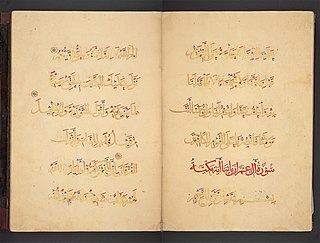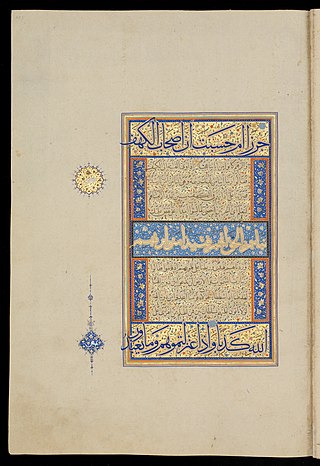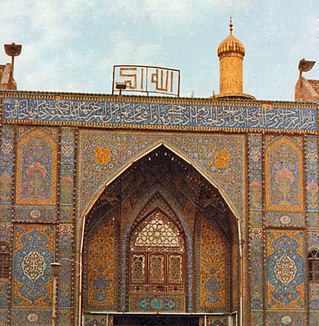The Pen, or Nūn is the sixty-eighth chapter (sūrah) of the Qur'an with 52 verses (āyāt). Quran 68 describes God's justice and the judgment day. Three notable themes of this Surah are its response to the opponents' objections, warning and admonition to the disbelievers, and exhortation of patience to the Islamic prophet Muhammad. Chronologically, this was the first appearance of any of the "disjointed" [i.e., single] letters (muqattaat) which precede a number of the surahs of the Qur'an, while in Quranic order this is the last surah to have the appearance of muqattaat.

Al Imran is the third chapter (sūrah) of the Quran with two hundred verses (āyāt).
At-Tawbah is the ninth chapter of the Quran. It contains 129 verses and is one of the last Medinan surahs. This Surah is known by two names, At-Taubah and Al-Bara'at. It is called At-Taubah in light of the fact that it articulates taubah (atonement) and informs about the conditions of its acceptance.. The name Bara'at (Release) is taken from the opening word of the Surah.

Al-Anfal is the eighth chapter (sūrah) of the Quran, with 75 verses (āyāt). Regarding the timing and contextual background of the revelation, it is a "Medinan surah", completed after the Battle of Badr. It forms a pair with the next surah, At-Tawba.

Al-An'am is the sixth chapter (sūrah) of the Quran, with 165 verses (āyāt). Coming in order in the Quran after Al-Fatiha, Al-Baqarah, Al 'Imran, An-Nisa', and Al-Ma'idah, this surah dwells on such themes as the clear signs of Allah's Dominion and Power, rejecting polytheism and unbelief, the establishment of Tawhid, the Revelation, Messengership, and Resurrection. It is a "Meccan surah", and it is believed to have been revealed in its entirety during the final year of the Meccan period of Islam. This explains the timing and contextual background of the believed revelation. The surah also reports the story of Ibrahim, who calls others to stop worshiping celestial bodies and turn towards Allah.

Al-Kahf is the 18th chapter (sūrah) of the Qur'an with 110 verses (āyāt). Regarding the timing and contextual background of the revelation, it is an earlier Meccan surah, which means it was revealed before Muhammad's hijrah to Medina, instead of after.
Al-Muʼminun is the 23rd chapter (sūrah) of the Qur'an with 118 verses (āyāt). Regarding the timing and contextual background of the supposed revelation, it is an earlier "Meccan surah", which means it is believed to have been revealed before the migration of the Islamic prophet Muhammad and his followers from Mecca to Medina (Hijra).
An-Naml is the 27th chapter (sūrah) of the Qur'an with 93 verses (āyāt).
The Spider is the 29th chapter (surah) of the Quran with 69 verses (āyāt).
Ar-Rum is the 30th chapter (sūrah) of the Quran, consisting of 60 verses (āyāt). The term Rūm originated in the word Roman, and during the time of the Islamic prophet Muhammad, it referred to the Eastern Roman Empire; the title is also sometimes translated as "The Greeks" or "The Byzantines".

As-Sajdah (السجدة), is the 32nd chapter (sūrah) of the Quran with 30 verses (āyāt). The name of the chapter has been translated as ۩ 'prostration' or 'adoration' and is taken from the fifteenth verse, which mentions those who "... fall prostrate and hymn the praise of their Lord".

Az-Zumar is the 39th chapter (surah) of the Qur'an, the central religious text of Islam. It contains 75 verses (ayat). This surah derives its name from the Arabic word zumar (troops) that occurs in verses 71 and 73. Regarding the timing and contextual background of the believed revelation, it is believed to have been revealed in the mid-Maccan period when persecutions of the Muslim believers by the polytheists had escalated.
Ghafir, also known as Al-Muʼmin, is the 40th chapter (sūrah) of the Qur'an, with 85 verses (āyāt). It takes its name from verse 28, which mentions a distinguished believer from among the clan of the Pharaoh who supported Moses, referring to him as a "believing man", hence al-Mu'min; The Believer. However, this surah is most often called al-Ghafir because of the Divine Name mentioned in verse 3.
Az-Zukhruf is the 43rd chapter (surah), of the Quran, the central religious text of Islam. It contains 89 verses (ayat).

Al-Qamar is the 54th chapter (surah) of the Quran, with 55 verses (ayat).The Surah was revealed in Mecca. The opening verses refer to the splitting of the Moon. "Qamar" (قمر), meaning "Moon" in Arabic, is also a common name among Muslims.
Ar-Rahman is the 55th Chapter (Surah) of the Qur'an, with 78 verses (āyāt).

In Islam, angels are believed to be heavenly beings, created from a luminous origin by God. The Quran is the principal source for the Islamic concept of angels, but more extensive features of angels appear in hadith literature, Mi'raj literature, Islamic exegesis, theology, philosophy, and mysticism.
In Islamic tradition the two kiraman katibin are two angels called Raqib and Atid, believed by Muslims to record a person's actions.

The Arabic term al-mu'aqqibat is a term occurring in the Quran (Q.13:11) which some Islamic commentators consider to refer to a class of guardian angel. Therefore, these Angels are also called al hafathah (الحفظة) which means the guarding angels. They protect human from the harm of evil jinn (جن) and devils (شياطين).








